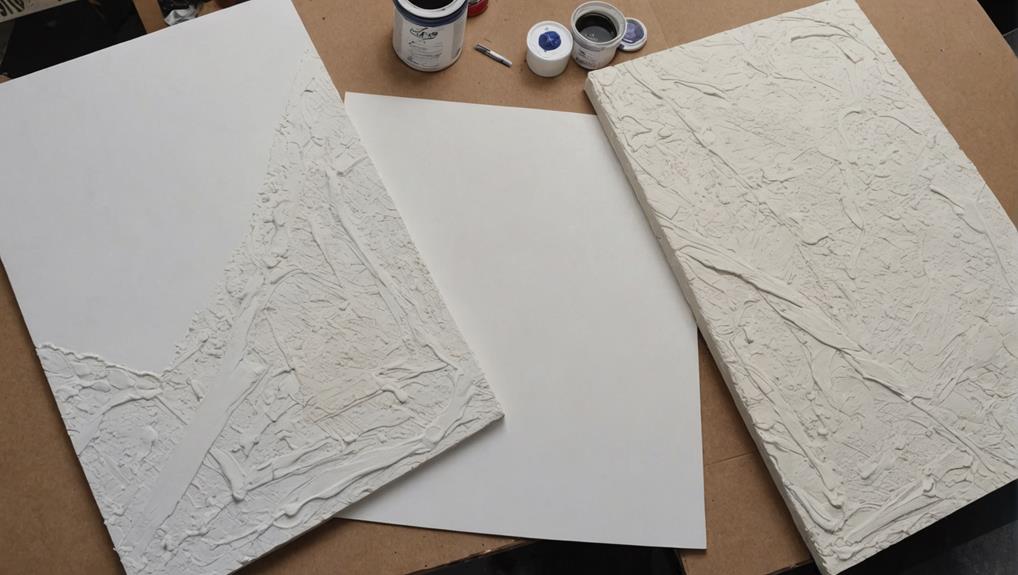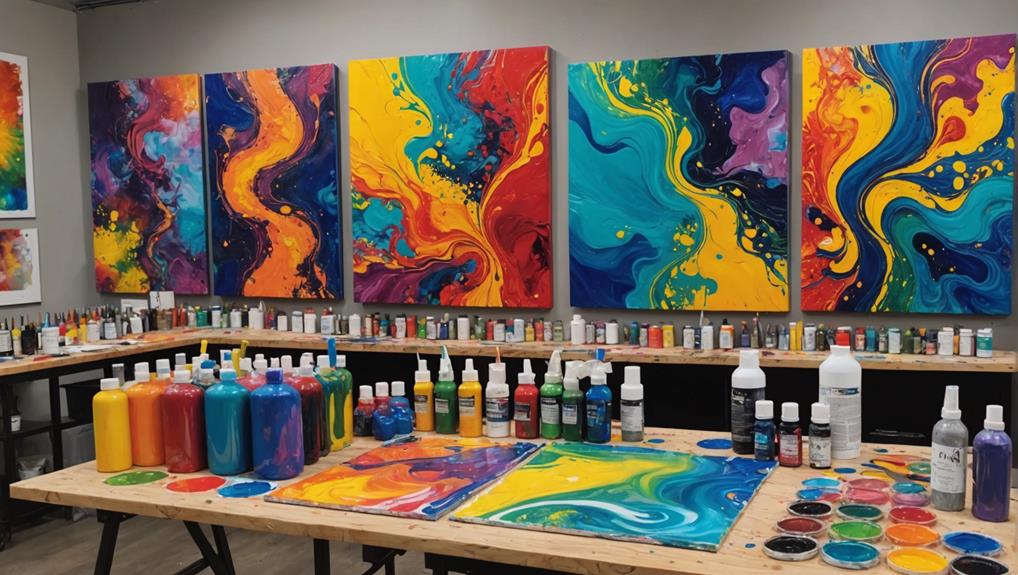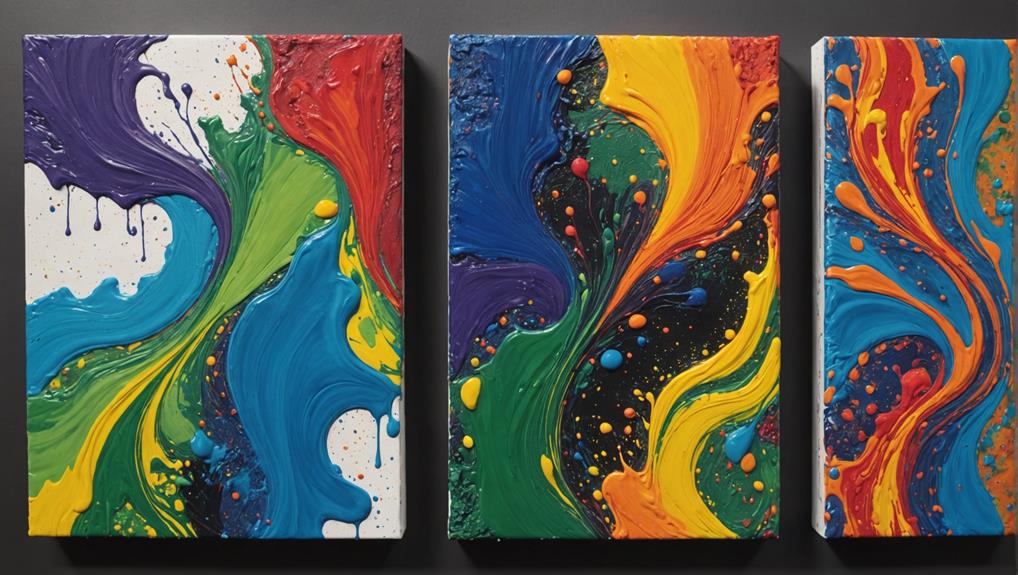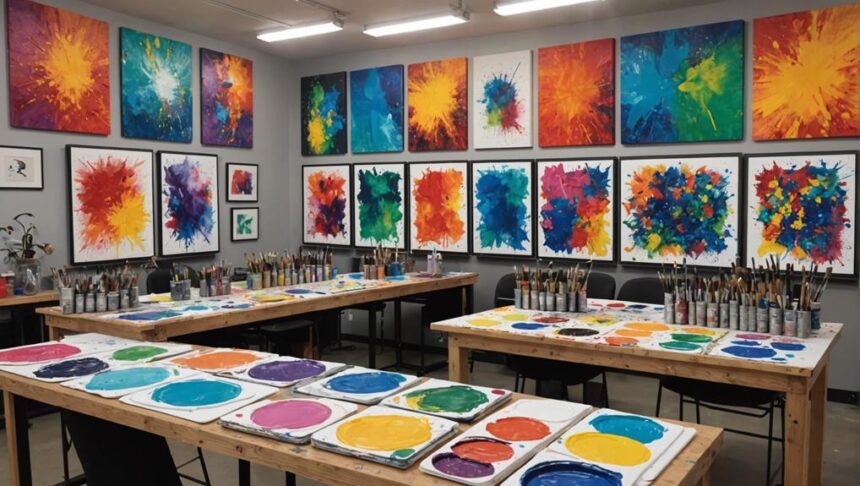When diving into the colorful world of fluid art, picking the right canvas is like choosing the perfect stage for your masterpiece. If you're just starting, a cotton canvas beckons with its smooth surface and vibrant color absorption – not to mention it's easy on the wallet! Feeling a bit more professional? Linen canvas, with its durability and refined finish, might just dazzle you. Don't forget synthetic canvases, especially for outdoor escapades with their water-resistant charm. And for those who crave convenience, pre-stretched canvases save tons of prep time. Stay tuned, and we'll unravel more secrets of these artistic foundations!
Key Takeaways
- Cotton canvas is affordable, widely available, and enhances color vibrancy due to excellent absorption.
- Linen canvas offers high durability, smooth surface, and better paint adherence, ideal for professional use.
- Synthetic canvas is water-resistant, prevents warping, and often comes pre-primed, suitable for outdoor projects.
- Pre-stretched canvases save time and provide consistent surface tension, eliminating the need for stretching and priming.
Overview of Canvas Types
Selecting the appropriate canvas type is vital for achieving desired results in fluid art, as each variant offers distinct characteristics and benefits.
One important aspect to take into account is the range of canvas texture variations available. For example, cotton canvas provides a smooth surface that is ideal for beginners, while linen canvas offers a finely woven texture that is favored by professionals due to its durability and refined finish.
Another key factor is canvas weight differences. Heavier canvases, such as those made from linen, tend to be more robust and can better withstand the heavy application of fluid art mediums. In contrast, lighter canvases like cotton are more affordable and easier to handle, making them suitable for artists who are just starting out.
Pre-stretched canvases are particularly convenient, as they come ready to use and guarantee a taut surface, which is essential for achieving even paint distribution.
Synthetic canvases, known for their water-resistant properties, are excellent for outdoor projects where moisture exposure is a concern.
Cotton Canvas Benefits
Among the various canvas options available for fluid art, cotton canvas stands out due to its affordability and versatility, catering to artists at all skill levels.
One of the key benefits of cotton canvas is its excellent absorption properties. The natural fibers soak up paint effectively, which can enhance the vibrancy and depth of colors in fluid art pieces. This makes it easier for artists to achieve striking, dynamic results.
Another significant advantage is the range of texture variations that cotton canvas offers. By applying different layers of gesso or other primers, artists can create surfaces that are either smooth or textured, depending on the desired effect. This flexibility allows for a wide array of creative possibilities in fluid art techniques.
Additionally, cotton canvas is widely available in both pre-stretched and unprimed forms, offering convenience for immediate use or custom preparation. This accessibility makes it a popular choice among beginners and seasoned artists alike.
- Affordable and widely available: Perfect for artists at all skill levels.
- Good absorption properties: Enhances color vibrancy in fluid art.
Linen Canvas Advantages
Renowned for its high durability and strength, linen canvas is a preferred choice for artists seeking a reliable and long-lasting surface for fluid art. The linen durability is unmatched, as these canvases resist sagging and warping over time, unlike their cotton counterparts. This makes them an excellent investment for serious artists who want their work to stand the test of time.
One of the standout texture benefits of linen canvas is its natural fiber composition, offering a finer texture that allows paint to adhere more effectively. This means that when you're working with fluid art techniques, the intricate details and vibrant colors are captured more clearly.
In addition, linen canvases typically boast a higher thread count, providing a smoother painting surface. This smoothness enhances the vibrancy and clarity of the colors, making your artwork pop.
Although linen canvases come at a higher price point, their ability to hold heavy applications of paint without compromising the surface's integrity is worth the investment. For artists looking to create pieces that are both visually stunning and structurally sound, linen canvas provides an unparalleled quality that justifies its cost.
Synthetic Canvas Uses
Synthetic canvas offers a versatile and resilient surface ideal for fluid art, particularly in settings where moisture exposure is a concern. This makes it a top choice for artists looking to create stunning outdoor applications.
Made from durable materials like polyester or a blend of synthetic fibers, synthetic canvas boasts several distinct advantages that make it particularly suitable for fluid art techniques.
One of the primary synthetic advantages is its water-resistant quality, which guarantees that the canvas can withstand heavy applications of paint without warping or deteriorating. Additionally, the smooth texture of synthetic canvas allows fluid paints to glide effortlessly, enabling artists to achieve seamless blends and intricate designs with ease.
Moreover, synthetic canvases often come pre-primed, saving artists valuable preparation time and guaranteeing that the surface is ready to use right out of the package. This feature enhances compatibility with various acrylic pouring techniques, making it a convenient option for fluid artists.
- Durability: Withstands heavy paint and environmental stress.
- Smooth Texture: Facilitates seamless paint blends.
The lightweight nature of synthetic canvas also makes it easy to transport, perfect for artists who enjoy painting in different locations or en plein air.
Pre-Stretched Canvas Convenience
Pre-stretched canvases are a game-changer for fluid artists, offering a ready-to-use advantage that saves precious time.
This convenience is especially beneficial for beginners who might find the process of stretching and priming canvases intimidating.
With the added benefit of professional tensioning and a smooth, pre-primed surface, pre-stretched canvases make it easier for artists to focus on their creative expression.
Ready-to-Use Advantage
One significant advantage of using pre-stretched canvases for fluid art is their convenience, as they come pre-primed and ready for immediate use, eliminating the need for additional preparation. The pre-stretched benefits are particularly appealing for artists who value painting readiness, allowing them to dive right into their creative process without delay. This convenience is especially essential for fluid art, where the consistency and flow of the paint can be time-sensitive.
Pre-stretched canvases offer several perks that enhance the painting experience:
- Consistent Surface Tension: This reduces the risk of sagging, which can cause undesirable pooling of paint, guaranteeing a professional finish.
- Variety of Sizes and Weights: Artists can choose from an array of options to suit their specific project needs, making these canvases versatile for different art styles.
Moreover, pre-stretched canvases are lightweight and portable, ideal for artists who enjoy outdoor painting sessions or need to travel with their supplies. This ready-to-use advantage not only saves time but also guarantees that artists can focus solely on their creativity, maximizing their artistic potential.
Time-Saving Benefits
Utilizing pre-stretched canvases allows artists to bypass the labor-intensive process of surface preparation, thereby considerably accelerating the commencement of their fluid art projects. These canvases come pre-primed, which means there's no need to spend time applying gesso layers—an essential step for most other canvas types. This setup efficiency is a game-changer, especially for artists who want to dive straight into the creative process without the distraction of preparatory work.
Pre-stretched canvases are available in various sizes, making it easy to pick the right dimensions without custom stretching. This convenience further reduces setup time, allowing artists to maintain their creative focus. The canvases are already tensioned to provide a taut surface, preventing issues like sagging and paint pooling that can disrupt fluid painting techniques.
Moreover, many of these canvases are made from high-quality materials, ensuring durability and a polished final product without additional effort. By eliminating the need for extensive preparation, pre-stretched canvases free up valuable time and energy, enabling artists to channel their efforts directly into their art. This not only enhances productivity but also enriches the overall creative experience.
Ideal for Beginners
For beginners entering the world of fluid art, the convenience of pre-stretched canvases offers a significant advantage by eliminating the need for time-consuming surface preparation.
These canvases come pre-primed with gesso, giving newcomers a smooth, ready-to-use surface that makes diving into fluid art a breeze. This is especially helpful for those just starting, as it reduces the risk of common mistakes, such as uneven paint application or surface warping.
Furthermore, pre-stretched canvases are available in a variety of sizes, allowing beginners to experiment with different dimensions without the hassle of stretching and priming their own canvas. This flexibility can be a real confidence booster, making it easier to focus on creative expression rather than technical details.
- Time-Saving: No need to stretch or prime the canvas, so you can start painting right away.
- Prevents Paint Pooling: The taut surface guarantees your paint spreads evenly, helping to avoid those frustrating puddles.
Canvas Boards Portability
Given their lightweight nature and rigid backing, canvas boards offer unparalleled portability for artists engaged in fluid art. One of the primary portability advantages is their resistance to warping, a common issue with traditional stretched canvases. This stability guarantees that the fluid art techniques, which often involve pouring and tilting, remain unaffected during transport.
Additionally, canvas boards come in various sizes, known as canvas board dimensions, allowing artists to select the perfect size for their project without sacrificing ease of movement.
The rigid backing of canvas boards provides another layer of support, making them easier to handle when working with fluid mediums. This feature is particularly beneficial for artists who prefer to create on the go or in diverse locations, as it minimizes the risk of damaging the artwork.
Furthermore, the lightweight nature of canvas boards means that artists can carry multiple pieces without feeling burdened, making them an excellent choice for outdoor painting sessions or art classes.
Priming and Preparation

Before you start pouring your paint, it's critical to prime your canvas properly so the colors pop and spread evenly.
Gesso is the go-to primer for most artists, but choosing the right type can make a big difference in how your masterpiece turns out.
Whether you prefer oil or acrylic paints, a well-primed canvas guarantees your artwork stays vibrant and smooth without the paint soaking through.
Importance of Priming
Priming a canvas is a critical step in the preparation process that directly influences the adhesion, vibrancy, and longevity of the paint.
Without proper gesso application, the paint may not adhere well, leading to uneven coverage and dull colors. Gesso acts as a barrier, preventing the paint from soaking into the canvas fibers, which guarantees a smoother, more vibrant finish.
Priming is especially important for fluid art, where paint flow and consistency are key. An unprimed canvas can absorb the liquid too quickly, causing the colors to lose their vibrancy and creating unwanted texture variations. A primed surface, on the other hand, allows the paint to glide smoothly and maintain its integrity, resulting in beautiful, flowing patterns.
- Enhanced Paint Adhesion: Gesso application helps the paint stick better to the canvas, reducing the risk of peeling or flaking.
- Improved Color Vibrancy: Priming guarantees that the colors remain bright and true, rather than being absorbed and dulled by the raw canvas.
Choosing Primer Type
Selecting the appropriate primer is essential for guaranteeing a smooth and vibrant finish in fluid art.
Priming is vital whether you're using oil or acrylic paints because it prevents the paint from soaking into the canvas, making sure your masterpiece pops with color. The most common primer you'll encounter is gesso. Gesso types vary, and choosing the right one depends on your artistic goals. If you want a sleek, detailed look, smooth gesso is your best bet. But if you're after a textured, dynamic feel, a rougher gesso can add that extra depth to your fluid art.
Priming techniques also play a big role. A well-primed canvas not only makes colors more vivid but also stops the paint from seeping into the canvas fibers—trust me, that's not a look you want!
To get it just right, always let the primer dry completely before diving into your painting. This guarantees the primer bonds well and prevents any frustrating lifting during the pouring process.
Canvas Sizing Considerations
When choosing a canvas for fluid art, considering the size is essential as it directly impacts the preparation, execution, and final presentation of the artwork. The dimensions of the canvas determine how much space you have to work with, which can affect your creative choices.
Larger canvases offer more room for intricate designs but require more paint and careful handling to avoid sagging. Meanwhile, smaller canvases are easier to manage but may limit your artistic expression.
Weight considerations are also vital. Heavier canvases, measured in ounces, provide greater durability and are less likely to warp during the fluid pouring process. This stability is essential for achieving a smooth, even finish.
Thickness: Thicker canvases support heavy applications of fluid paint without sagging, maintaining structural integrity.
Thread Count: A higher thread count offers a finer texture, enhancing paint adherence and the overall finish quality.
Custom Sizing: Custom-sized canvases allow artists to tailor dimensions specific to their artistic vision, providing flexibility in fluid pouring techniques.
Painting Techniques on Canvas

Understanding the intricacies of painting techniques on canvas can greatly enhance the quality and impact of fluid art, building on the foundational choices of canvas size and material.
Different painting styles, such as pouring and high-viscosity applications, require thoughtful canvas selection. For instance, oil painting on canvas necessitates a primed surface, often treated with gesso, to prevent paint absorption and guarantee ideal results. Conversely, acrylic paints are more versatile, adhering well to various canvas types even without extensive priming.
When engaging in high-viscosity techniques, a thicker canvas is vital. It provides the necessary support and durability, reducing the risk of sagging or warping during the drying process. For mixed media projects, pre-stretched canvases or cradled wood panels are preferable. These surfaces can handle various materials and techniques, adding dimensionality to the artwork.
Texture application on canvas, achieved through layering and manipulating paint with gloss gel mediums or liquid latex, brings depth and interest to fluid art. Additionally, using canvases with a suitable weight and thread count guarantees better paint adherence. This is essential for vibrant, long-lasting results, particularly in complex color mixing and detailed painting styles.
Care and Maintenance Tips
Proper care and maintenance of canvases are essential for preserving the longevity and vibrancy of fluid art pieces. Neglecting these aspects can lead to unfortunate consequences like warping, mold growth, or even fading colors. To avoid such mishaps, let's explore some simple yet effective tips.
First and foremost, canvas cleaning is vital. Regularly dust your canvases with a soft cloth to keep them looking fresh and clean. Avoid using harsh chemicals that might harm the paint or the canvas itself.
Maintaining proper humidity control is another key factor. Store your canvases in a dry, cool environment to prevent any moisture-related damage. Humidity can cause canvases to warp or even develop mold, which can be disastrous for your artwork.
Here are some quick tips to keep in mind:
- Store canvases in a dry, cool place to prevent warping and mold.
- Dust regularly with a soft cloth, avoiding harsh chemicals.
Lastly, always display your canvases away from direct sunlight. This will help in minimizing any fading or discoloration over time, ensuring your fluid art pieces remain vibrant for years to come.
Choosing the Right Canvas

When it comes to choosing the right canvas for your fluid art, the material you pick can considerably impact your final piece.
Cotton canvases are great for affordability and versatility, while linen offers a more professional quality with its durability and texture.
Additionally, understanding preparation techniques like priming with gesso can help create a smooth surface that enhances your colors and prevents unwanted paint absorption.
Canvas Material Options
Choosing the suitable canvas material is essential for achieving ideal results in fluid art. The right canvas can make a significant difference in the final outcome of your artwork. When considering canvas texture options and canvas weight differences, it's important to understand the characteristics of various materials.
Cotton canvas is a cost-effective choice, ideal for beginners. It holds paint well, and its availability makes it a go-to option for many artists. However, it might not offer the same longevity as other materials.
Linen canvas is preferred by professionals due to its superior durability and smoother surface. Although more expensive, linen enhances the quality of fluid art by providing a consistent texture that allows for intricate details.
Synthetic canvases are perfect for outdoor projects. Their water-resistant nature guarantees they withstand moisture, making them highly practical for fluid art exposed to the elements.
Canvas options also vary in form:
- Pre-stretched canvases: Ready to use, saving time on preparation.
- Canvas boards: Lightweight and portable, great for experiments.
Preparation Techniques Explained
To maximize the potential of your fluid art, understanding and implementing the correct preparation techniques for your chosen canvas is vital. Each type of canvas—cotton, linen, or synthetic—requires specific canvas preparation methods to guarantee the best results.
Cotton canvas, known for being affordable and versatile, is a go-to for many artists. However, to save time and effort, opting for pre-stretched and primed versions is recommended.
Linen canvas, favored by professionals, offers superior durability and a high-quality surface, perfect for handling heavy paint applications.
Meanwhile, synthetic canvas stands out for its water resistance, making it the ideal choice for outdoor projects due to its resilience against the elements.
Priming techniques comparison is essential when preparing your canvas. Applying gesso is necessary, especially when working with oil or acrylic paints.
This primer prevents the canvas from absorbing the paint, guaranteeing a smooth application and vibrant colors.
Also, choosing a canvas with a higher thread count can notably enhance paint adherence and the overall finish quality of your fluid art.
Frequently Asked Questions
What Is the Best Canvas for Fluid Art?
The best canvas for fluid art depends on the artist's needs. Cotton canvas offers versatility, while linen provides superior canvas texture and durability. Pre-stretched canvases simplify surface preparation, and synthetic options are ideal for water-resistant projects.
What Type of Canvas Is Best for Oil Paint?
Linen canvas, known for its durability and fine texture, is ideal for oil painting. Proper priming techniques are essential to guarantee oil paint compatibility, preventing damage and enhancing the richness of colors and texture.
What's the Difference Between Level 2 and Level 3 Canvas?
The primary differences between Level 2 and Level 3 canvas are durability, canvas texture, and canvas priming. Level 3 canvas offers higher weight, finer texture, and superior priming, making it more suitable for advanced art techniques.
What Is the Best Weight Canvas for Oil Painting?
The best weight canvas for oil painting ranges from 10 to 12 ounces per square yard. This weight provides ideal canvas durability and a suitable canvas texture, allowing for enhanced paint adherence and detailed artistic expression.
Conclusion
In fluid art, selecting the appropriate canvas is essential.
Cotton canvas offers affordability and versatility, while linen provides durability and a refined texture.
Synthetic canvases are beneficial for their resistance to environmental factors.
Pre-stretched canvases offer convenience, saving time and effort.
Considerations such as canvas sizing and painting techniques further influence the choice.
Proper care and maintenance guarantee longevity.
Ultimately, the right canvas enhances the artistic process and the final artwork's quality and appearance.


Leave a Reply